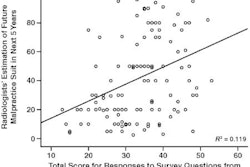Remember all those grade reports your school sent home? Whether you waited at the mailbox to intercept the deadly document before mom and dad got hold of it, or whether you carried it to your parents proudly, the fact that your work was being measured against that of your peers was a powerful motivator, hopefully for self-improvement.
Now that healthcare providers are being challenged to offer the best possible care in the most cost-efficient way, breast imaging centers can also benefit from "grades" -- a way to track quality indicators across various categories and compare them to internal and external data, according to Bonnie Rush, consultant and president of Breast Imaging Specialists of San Diego.
"The basis for tracking quality is a desire to do the right thing at the right time and in a timely manner," Rush said. "It's up to each breast imaging facility to establish a policy for an internal audit that compares its data to national or local standards."
Centers can assess patient satisfaction, cost-effectiveness, and staff performance. But what's most crucial is keeping track of clinical indicators of quality, according to Dr. Michael Linver, vice president of the National Consortium of Breast Centers (NCBC) in Warsaw, IN, and a practicing radiologist at X-Ray Associates of New Mexico in Albuquerque.
"The most important quality indicator for a breast center is whether the radiologists are finding the cancers," he said. "And tracking quality can also help a facility assess whether all its radiologists are working at the same level. If there are outliers, quality data helps the center identify and address the problem."
A center's reputation can hang in the balance if it doesn't pay attention to its quality indicators, according to Lillie Shockney, administrative director of the Johns Hopkins Avon Foundation Breast Center in Baltimore and quality initiative chair of the NCBC.
"You can't manage what you're not measuring," Shockney said. "And if it comes out that patients are having complications or are waiting forever for results, that's going to be a problem for a breast center."
Better benchmarking
Some centers track their progress by comparing internal data year to year with mammography reporting software from companies such as Mammography Reporting System of Seattle, MagView of Burtonsville, MD, Misys of Raleigh, NC, or PenRad Technologies of Minnetonka, MN.
Using mammography reporting software is a helpful place to start, but breast center quality assurance data becomes even more useful once it's compared to other like facilities. Yet it's challenging to find data on similar centers, according to Theresa Wade, administrator at Elizabeth Wende Breast Care Clinic in Rochester, NY.
"You have to use benchmarks with common sense, because the data you're using to compare yourself may not be comparable," Wade said. "We're a high-volume facility that just does breast imaging, and if we use Medical Group Management Association general radiology benchmarks, it's just not going to fit."
At Elizabeth Wende, tracking quality has been a multifaceted approach, including not only internal data compared year-to-year, but also data taken from patient surveys. The center has two patient advocates on the floor all day interacting with women and trying to sort out problems as they arise, according to imaging and compliance manager Valerie Andolina.
"We feel that quality is not just QA or medical audit, but it's how we treat our patients and how professional our staff is," Andolina said. "Our patient advocates put out many fires every day. Part of their job is to review patient quality surveys and respond back to questions or concerns."
Help on the web
Breast center types are diverse and each has unique quality indicators, according to the NCBC:
|
||||||||||||||||||||||||||||||||||||||||||||||||||||||||||||||||||||||||
| Types of breast centers and services they provide with quality control measuring. "X" means this type of center must provide this component, "M" means this type of center may provide this component, and "O" means this type of center would not be expected to provide this component. Courtesy of the NCBC. |
In 2007, the NCBC started a free, Web-based program called National Quality Measures for Breast Centers. Through the program, breast centers of any type can enter relevant data and then compare themselves to other similar centers. The program now has about 200 participants, according to Emily McAllister, public relations and project manager.
"We have a wide range of breast centers involved, and we encourage centers of any type to participate," McAllister said. "It's convenient, because a center doesn't have to set up its own benchmarking software and laboriously find other centers that are comparable to which to compare itself."
The NCBC's program classifies breast centers using two main variables:
- Breast center profile characteristics, which include:
- Size of breast cancer facility
- Size of community it serves
- Volume of patients seen
- Number of mammograms performed annually
- Patient characteristics
- Regional location
- Provider compensation structure
- Provided components of service, i.e., those services offered that can be tracked and impacted with data for quality control
Those who use this database can compare themselves against all other participants, or they can filter for specific characteristics, according to Shockney.
"We wanted to provide a mechanism for breast centers, no matter what size, kind, or ability, to collect and enter data and compare themselves against other, like centers," she said. "We found that many centers weren't doing anything to track quality, so just having facilities agree to measure quality indicators is a big deal. And there's the opportunity to learn from each other, to ask questions like, 'How did you measure this indicator, and how did you go about improving the numbers?' "
The NCBC's program was developed with reference to the Mammography Quality Standards Act (MQSA) of 1992 and with help from the Advisory Board Company's Oncology Roundtable. The Washington, DC-based Advisory Board Company surveyed breast centers, asking each what it was measuring and why that measurement was important, to determine quality indicators. The NCBC added more to that list.
The program looks primarily at processes of care, according to Shockney, and its developers have tried to be as clear as possible about how quality measures are defined. For example, when assessing turnaround time between breast biopsy and pathology, it's important to identify when the clock starts ticking; for example, when evaluating the completeness of a surgical pathology for a lumpectomy, it's important to clarify what "complete" means in the indicator.
As the program gains momentum, it will further identify quality parameters, Shockney said.
"In some incidences of quality indicators there have been no standards, so this program will help establish those," she said. "But in that case the key question is always, 'Is this as good as it gets, or can we do better?' "
Boosting the bottom line
Breast centers want to measure their quality in order to provide the best patient care possible. But the added benefit is that providing this excellent care helps a center nab that competitive edge in their market, according to Terry Bucknall, director of women's imaging services at Sheila R. Veloz Breast Imaging Center in Valencia, CA.
"We want to be competitive within our market so we can attract the finest specialists to the area, which will, in turn, attract more patients," she said. "The more we get patients back into the office for diagnostic workups in a timely fashion, the more we track our callback rates, the better we get."
The goal is to exceed existing quality guidelines, Elizabeth Wende's Wade said.
"We want to go beyond established standards, say from the American College of Radiology," she said. "The only way to do that is to watch your data all the time, watch your outcomes, so you know whether you're getting better or not."
By Kate Madden Yee
AuntMinnie.com staff writer
February 17, 2009
Related Reading
Web-based radiology dashboard aids in practice management, December 1, 2008
Home-grown databases assist radiology administrators, July 31, 2008
Radiology groups need new approaches to survive in tough times, January 15, 2009
The best way to run your practice? Look to corporate America, April 3, 2008
Tracking radiology performance with a dashboard, September 10, 2007
Copyright © 2009 AuntMinnie.com




















